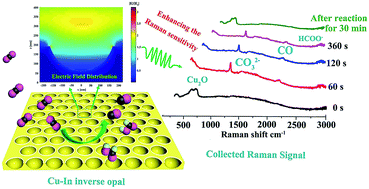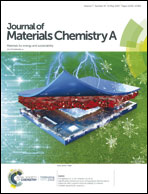“Hot edges” in an inverse opal structure enable efficient CO2 electrochemical reduction and sensitive in situ Raman characterization†
Abstract
Conversion of CO2 into fuels and chemicals via electroreduction has attracted significant interest. Via mesostructure design to tune the electric field distribution in the electrode, it is demonstrated that the Cu–In alloy with an inverse opal (CI-1-IO) structure provides efficient electrochemical CO2 reduction and allows for sensitive detection of the CO2 reduction intermediates via surface-enhanced Raman scattering. The significant enhancement of Raman signals of the intermediates on the CI-1-IO surface can be attributed to electric field enhancement on the “hot edges” of the inverse opal structure. Additionally, a highest CO2 reduction faradaic efficiency (FE) of 92% (sum of formate and CO) is achieved at −0.6 V vs. RHE on the CI-1-IO electrode. The diffuse reflectance infrared Fourier transform spectroscopy (DRIFTS) results show that the Cu–In alloy with an inverse opal structure has faster adsorption kinetics and higher adsorption capacity for CO2. The “hot edges” of the bowl-like structure concentrate electric fields, due to the high curvature, and also concentrate K+ on the active sites, which can lower the energy barrier of the CO2 reduction reaction. This research provides new insight into the design of materials for efficient CO2 conversion and the detection of intermediates during the CO2 reduction process.



 Please wait while we load your content...
Please wait while we load your content...